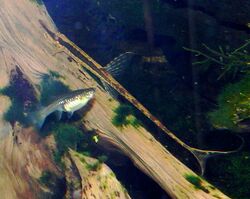Biology:Farlowella
| Farlowella | |
|---|---|

| |
| Farlowella acus | |
| Scientific classification Error creating thumbnail: Unable to save thumbnail to destination
| |
| Domain: | Eukaryota |
| Kingdom: | Animalia |
| Phylum: | Chordata |
| Class: | Actinopterygii |
| Order: | Siluriformes |
| Family: | Loricariidae |
| Tribe: | Harttiini |
| Genus: | Farlowella C. H. Eigenmann & R. S. Eigenmann, 1889 |
| Type species | |
| Acestra acus Kner, 1853
| |
Farlowella is a genus of fish in the family Loricariidae native to South America. This genus is broadly distributed in Amazon, Orinoco, Paraná and coastal rivers of the Guyana Shield. It is absent from the Pacific slope of the Andes and from the coastal rivers of the Brazilian Shield.[1] Many of these species are kept in aquariums. This genus has a unique body shape that resembles a thin stick of wood. The body is slender and elongate, often with a pronounced rostrum and a brownish color with two lateral dark stripes beginning at the tip of the rostrum, passing over the eyes and ending at the tail, which are periodically interrupted on the caudal peduncle.[1]
Taxonomy
The genus is placed within the tribe Harttiini of the subfamily Loricariinae. Morphological, molecular and phylogenetic studies have placed Farlowella as sister to Sturisoma.[1] The genus name of Farlowella is named in honor of William Gilson Farlow, a famous United States botanist of Harvard University whose main work was working with algae plants, the favorite food of this slender catfish.[2]
Species
There are currently 28 recognized species in this genus:
- Farlowella acus (Kner, 1853)
- Farlowella altocorpus Retzer, 2006
- Farlowella amazonum (Günther, 1864)[3]
- Farlowella colombiensis Retzer & Page, 1997
- Farlowella curtirostra G. S. Myers, 1942
- Farlowella gianetii Ballen, Pastana & L. A. W. Peixoto, 2016 [4]
- Farlowella gracilis Regan, 1904
- Farlowella hahni Meinken, 1937
- Farlowella hasemani C. H. Eigenmann & Vance, 1917
- Farlowella henriquei A. Miranda-Ribeiro, 1918
- Farlowella isbruckeri Retzer & Page, 1997
- Farlowella jauruensis C. H. Eigenmann & Vance, 1917 [4]
- Farlowella knerii (Steindachner, 1882)
- Farlowella mariaelenae Martín Salazar, 1964
- Farlowella martini Fernández-Yépez, 1972
- Farlowella mitoupibo Ballen, Urbano-Bonilla & Zamudio, 2016 [5]
- Farlowella nattereri Steindachner, 1910
- Farlowella odontotumulus Retzer & Page, 1997
- Farlowella oxyrryncha (Kner, 1853)
- Farlowella paraguayensis Retzer & Page, 1997
- Farlowella reticulata Boeseman, 1971
- Farlowella rugosa Boeseman, 1971
- Farlowella schreitmuelleri C. G. E. Ahl, 1937
- Farlowella smithi Fowler, 1913
- Farlowella taphorni Retzer & Page, 1997
- Farlowella venezuelensis Martín Salazar, 1964
- Farlowella vittata G. S. Myers, 1942
- Farlowella yarigui Ballen & Mojica, 2014 [6]
References
- ↑ 1.0 1.1 1.2 Covain, R. & Fisch-Muller, S. (2007): The genera of the Neotropical armored catfish subfamily Loricariinae (Siluriformes: Loricariidae): a practical key and synopsis. Zootaxa, 1462: 1–40.
- ↑ Froese, Rainer and Pauly, Daniel, eds. (2016). Species of Farlowella in FishBase. October 2016 version.
- ↑ "WoRMS - World Register of Marine Species - Farlowella amazonum (Günther, 1864)". https://www.marinespecies.org/aphia.php?p=taxdetails&id=1014929.
- ↑ 4.0 4.1 Ballen, G.A., Pastana, M.N.L. & Peixoto, L.A.W. (2016): A new species of Farlowella (Siluriformes: Loricariidae) of the F. nattereri species-group from the rio Xingu basin, Mato Grosso, Brazil, with comments on Farlowella jauruensis, a poorly-known species from the upper rio Paraguai basin. Neotropical Ichthyology, 14 (3): e160046.
- ↑ Ballen, G.A., Urbano-Bonilla, A. & Zamudio, J.E. (2016): Farlowella mitoupibo, a new species of stick catfish from the upper Guaviare River, Orinoco basin, Colombia (Teleostei: Loricariidae). Ichthyological Exploration of Freshwaters, 27 (4): 325-332.
- ↑ Ballen, G.A. & Mojica, J.I. (2014): A new trans-Andean Stick Catfish of the genus Farlowella Eigenmann & Eigenmann, 1889 (Siluriformes: Loricariidae) with the first record of the genus for the río Magdalena Basin in Colombia. Zootaxa, 3765 (2): 134–142.
Wikidata ☰ Q134999 entry
 |

